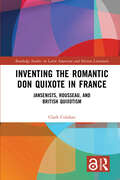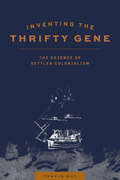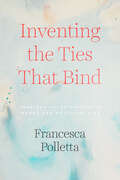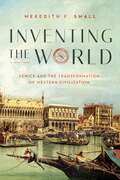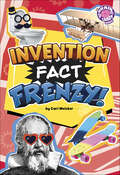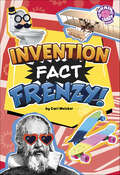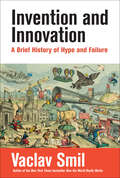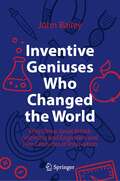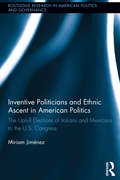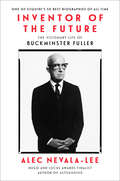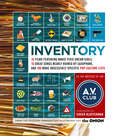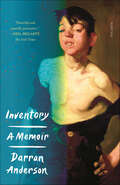- Table View
- List View
Inventing the Romantic Don Quixote in France: Jansenists, Rousseau, and British Quixotism (Routledge Studies in Latin American and Iberian Literature)
by Clark ColahanCervantes’ now mythical character of Don Quixote began as a far different figure than the altruistic righter of wrongs we know today. The transformation from mad highway robber to secular saint took place in the Romantic Era, but how and where it began has just begun to be understood. Germany and England played major roles, but, contrary to earlier literary historians, Pascal, Racine, Rousseau and the Jansenists scooped Henry and Sarah Fielding. Jansenism, a persecuted puritanical and intellectual movement linked to Pascal, identified itself with Don Quixote’s virtues, excused his vices, and wrote a game-changing sequel mediated by the transformative powers of a sorcerer from Commedia dell’Arte. As an early Romantic, Rousseau was attracted to the hero’s fertile imagination and tender love for Dulcinea, foregrounding the would-be knight’s quest in a play and his best-selling novel, Julie. Sarah Fielding reacted similarly, basing her utopian novel David Simple on the Jansenist concept of quixotic trust in others. Colahan here reproduces and explains for the first time the extremely rare original illustrations of the French sequel to Cervantes’ novel, and documents the fortunes in French culture of the magician at the heart of the Romantic Quixote.
Inventing the Thrifty Gene: The Science of Settler Colonialism
by Travis HayThough First Nations communities in Canada have historically lacked access to clean water, affordable food, and equitable health care, they have never lacked access to well-funded scientists seeking to study them. Inventing the Thrifty Gene examines the relationship between science and settler colonialism through the lens of “Aboriginal diabetes” and the thrifty gene hypothesis, which posits that Indigenous peoples are genetically predisposed to type 2 diabetes and obesity due to their alleged hunter-gatherer genes. Hay’s study begins with Charles Darwin’s travels and his observations on the Indigenous peoples he encountered, setting the imperial context for Canadian histories of medicine and colonialism. It continues in the mid-twentieth century with a look at nutritional experimentation during the long career of Percy Moore, the medical director of Indian Affairs (1946–1965). Hay then turns to James Neel’s invention of the thrifty gene hypothesis in 1962 and Robert Hegele’s reinvention and application of the hypothesis to Sandy Lake First Nation in northern Ontario in the 1990s. Finally, Hay demonstrates the way in which settler colonial science was responded to and resisted by Indigenous leadership in Sandy Lake First Nation, who used monies from the thrifty gene study to fund wellness programs in their community. Inventing the Thrifty Gene exposes the exploitative nature of settler science with Indigenous subjects, the flawed scientific theories stemming from faulty assumptions of Indigenous decline and disappearance, as well as the severe inequities in Canadian health care that persist even today.
Inventing the Ties That Bind: Imagined Relationships in Moral and Political Life
by Francesca PollettaFrom deciding to hold the door for the person behind you, to resolving for whom you will cast your vote, every day we find ourselves charged with making moral decisions. What steers our choices? And how do we weigh competing priorities and moral convictions? In Inventing the Ties That Bind, Francesca Polletta shows that we do not solve these dilemmas, whether personal or political, based on self-interest alone. Instead, relationships serve as a kind of moral compass. People consider the nature of their ties to one another to know what their obligations are, and in situations that are unfamiliar, they sometimes figure out the right thing to do by imagining themselves in relationships they do not actually have. Polletta takes up a wide range of cases, from debt settlement agencies to the southern civil rights movement, revealing that our relationships and how we imagine them are at the heart of our moral lives—guiding us as we choose whom to help and how we define what it means to treat someone as our equal. In a time of growing polarization, understanding how we make sense of our ties to one another is more urgent than ever.
Inventing the Working Parent: Work, Gender, and Feminism in Neoliberal Britain
by Sarah E. StollerThe first historical examination of working parenthood in the late twentieth century—and how the concepts of &“family-friendly&” work culture and &“work–life balance&” came to be.Since the 1980s, families across the developed West have lived through a revolution on a scale unprecedented since industrialization. With more mothers than ever before in paid work and the rise of the middle-class, dual-income household, we have entered a new era in the history of everyday life: the era of the working parent. In Inventing the Working Parent, Sarah E. Stoller charts the politics that shaped the creation of the phenomenon of working parenthood in Britain as it arose out of a new culture of work.Stoller begins with the first sustained efforts by feminists to mobilize politically on behalf of working parents in the late 1970s and concludes in the context of an emerging national political agenda for working families with the rise of New Labour in the 1990s. She explores how and why the notion of working parenthood emerged as a powerful new political claim and identity category and addresses how feminists used the concept of working parenthood to advocate for new organizational policies and practices. Lastly, Stoller shows how neoliberal capitalism under Margaret Thatcher and subsequent New Labour governments made a family&’s ability to survive on one income nearly impossible—with significant consequences for individual experience, the gendered division of labor, and intimate life.
Inventing the World: Venice and the Transformation of Western Civilization
by Meredith SmallAn epic cultural journey that reveals how Venetian ingenuity and inventions—from sunglasses and forks to bonds and currency—shaped modernity.How did a small, isolated city—with a population that never exceeded 100,000, even in its heyday—come to transform western civilization? Acclaimed anthropologist Meredith Small, the author of the groundbreaking Our Babies, Ourselves examines the the unique Venetian social structure that was key to their explosion of creativity and invention that ranged from the material to social. Whether it was boats or money, medicine or face cream, opera, semicolons, tiramisu or child-labor laws, these all originated in Venice and have shaped contemporary notions of institutions and conventions ever since. The foundation of how we now think about community, health care, money, consumerism, and globalization all sprung forth from the Laguna Veneta. But Venice is far from a historic relic or a life-sized museum. It is a living city that still embraces its innovative roots. As climate change effects sea-level rises, Venice is on the front lines of preserving its legacy and cultural history to inspire a new generation of innovators.
Invention Fact Frenzy! (Fact Frenzy)
by Cari MeisterThere&’s a INVENTION FACT FRENZY headed your way! Did you know that inventor Thomas Edison held more than 2,000 patents? Or that the first submarine was a rowboat covered in leather? Dozens of bite-size invention facts are paired with fun and unexpected photos, welcoming in even the most reluctant readers. Whether kids are in the mood to browse or to devour a book from cover to cover, even a budding young inventor is sure to learn something surprising as they flip through these pages.
Invention Fact Frenzy! (Fact Frenzy)
by Cari MeisterThere&’s a INVENTION FACT FRENZY headed your way! Did you know that inventor Thomas Edison held more than 2,000 patents? Or that the first submarine was a rowboat covered in leather? Dozens of bite-size invention facts are paired with fun and unexpected photos, welcoming in even the most reluctant readers. Whether kids are in the mood to browse or to devour a book from cover to cover, even a budding young inventor is sure to learn something surprising as they flip through these pages.
Invention and Innovation: A Brief History of Hype and Failure
by Vaclav SmilFrom the New York Times-bestselling author, a new volume on the history of human ingenuity—and its attendant breakthroughs and busts.The world is never finished catching up with Vaclav Smil. In his latest and perhaps most readable book, Invention and Innovation, the prolific author—a favorite of Bill Gates—pens an insightful and fact-filled jaunt through the history of human invention. Impatient with the hype that so often accompanies innovation, Smil offers in this book a clear-eyed corrective to the overpromises that accompany everything from new cures for diseases to AI. He reminds us that even after we go quite far along the invention-development-application trajectory, we may never get anything real to deploy. Or worse, even after we have succeeded by introducing an invention, its future may be marked by underperformance, disappointment, demise, or outright harm.Drawing on his vast breadth of scientific and historical knowledge, Smil explains the difference between invention and innovation. He then looks at three different types of inventions.Inventions that failed to dominate as promised:AirshipsNuclear fissionSupersonic flightInventions that turned disastrous:Leaded gasoline DDTChlorofluorocarbonsInventions we have long been promised (and that would be highly beneficial):Travel in vacuum (hyperloop)Nitrogen-fixing cerealsNuclear fusionFinally, he offers a &“wish list&” of inventions that we most urgently need to confront the staggering challenges of the twenty-first century.Filled with engaging examples and pragmatic approaches, this book is a sobering account of the folly that so often attends human ingenuity—and how we can, and must, better align our expectations with reality.
Invention of Peace
by Michael HowardThroughout history the overwhelming majority of human societies have taken war for granted and made it the basis for their legal and social structures. Not until the Enlightenment in the eighteenth century did war come to be regarded as an unmitigated evil and one that could be abolished by rational social organization, and only after the massive slaughter of the two world wars did this become the declared objective of civilized states. Nevertheless, war in one form or another continues unabated. In this elegantly written book, a preeminent military historian considers why this is so. Is war in some sense still a necessary element in international order? Are war and peace in fact complementary? Does not peace itself breed the conditions that will ultimately lead to war? And if nuclear weapons have made war ultimately suicidal for mankind, what can be done about it? Having devoted half a century largely to studying these questions, Michael Howard offers us his reflections. Unless they can be answered, he notes, the twenty-first century is unlikely to be any more peaceful than the centuries that preceded it.
Inventions and Discovery: Henry Ford and the Model T
by Phil Miller Charles Barnett Michael O'Hearn Keith Wilson Christopher HarboTells the story of Henry Ford, along with his invention, the popular Model T automobile.
Inventions in Sociology: Studies in Science and Society
by Sal RestivoThis book presents a collection of old and new essays exploring the author’s unique contributions to the sociology of science, mathematics, logic, robotics, brain, and god. Known for his defense of a strong social constructionist approach to the hard problems in the sociology of science, the power and range of Restivo’s interests and studies are discussed in this unique text. The essays range from his introduction of the sociology of objectivity early in his career to his recent construction of a social brain paradigm. The author situates himself in the context of the leading paradigms in science studies and his relationships with leading figures in the field including Latour, Woolgar, Needham, and D.T. Campbell. The book demonstrates a general theoretical focus on the rejection of transcendence. He rejects Platonism in mathematics and socially situates consciousness, genius, and God. The author’s wide ranging interdisciplinary competencies reflect classical and postmodern influences and will be an invaluable reference for researchers working in this field.
Inventive Geniuses Who Changed the World: Fifty-Three Great British Scientists and Engineers and Five Centuries of Innovation
by John BaileyThis book describes the life and times of fifty-three great British scientists and engineers – male and female inventive geniuses who changed the world, improving the lives of mankind, and propelling humanity forward. Their stories abound with personal ingenuity, brilliance and scientific or engineering wizardry, and with the ambition to satisfy fundamental human needs. The author aspires to set these individual achievements in the socio-political context of their place in history, sometimes embracing the activities of others to round off the story and scientific contribution. Avoiding overly technical language, he nonetheless succeeds in making complex theories and technologies more comprehensible and accessible to a lay audience. This book is a must for all those interested in the prehistory and history of the steam engine, transport, communication technology, public health services, and many topics from the natural sciences. Many of the inventions described in its pages have helped shape the modern world.
Inventive Politicians and Ethnic Ascent in American Politics: The Uphill Elections of Italians and Mexicans to the U.S. Congress (Routledge Research in American Politics and Governance)
by Miriam JiménezThis innovative book investigates the process through which ethnic minorities penetrate into higher echelons of political power: specifically, how they succeed in getting elected to the U.S. Congress. Analysts today see ethnic politicians largely in relation to their collectivities, but by actually studying what ethnic minority politicians do and the issues they have faced, Jiménez's book offers an original perspective of analysis. Jiménez utilizes a ground-breaking comparative dataset of elected members of Congress organized upon the basis of national origin, the first available. Using the cases of Mexican-Americans and Italian-Americans, Jimenez analyzes and compares the different ways that these ethnic politicians have been elected to the national legislature from the beginning of the 20th century until the present. Her study examines Italian and Mexican-American politicians’ actions and interactions with local political parties, identifies various layers of political power that have influenced their successes and failures, and uncovers the strategies that they have used. Jimenez argues that the politically active segment of an ethnic group matters in the process of political incorporation of a group. She also asserts that regular access of ethnic groups into upper levels of political office and the full acceptance of new ethnic players only occurs as a consequence of an institutional change. Jiménez’s pioneering documentation and analysis of the strategies of ethnic minority politicians and the ways that political institutions have influenced these politicians is significant to scholars of political incorporation, race and ethnicity, and congressional elections. Her book demonstrates the need to reconsider several standard ideas of how minority representation occurs and deepens our understanding of the role that political institutions play in that process.
Inventor of the Future: The Visionary Life of Buckminster Fuller
by Alec Nevala-LeeOne of Esquire's 50 Best Biographies of All Time * One of The Economist's Best Books of 2022 * A New York Times Book Review Editors' Choice * Nominated for The Next Big Idea Club * The Week Magazine Book of the WeekFrom Alec Nevala-Lee, the author of the Hugo and Locus Award finalist Astounding, comes a revelatory biography of the visionary designer who defined the rules of startup culture and shaped America’s idea of the future. During his lifetime, Buckminster Fuller was hailed as one of the greatest geniuses of the twentieth century. As the architectural designer and futurist best known for the geodesic dome, he enthralled a vast popular audience, inspired devotion from both the counterculture and the establishment, and was praised as a modern Leonardo da Vinci. To his admirers, he exemplified what one man could accomplish by approaching urgent design problems using a radically unconventional set of strategies, which he based on a mystical conception of the universe’s geometry. His views on sustainability, as embodied in the image of Spaceship Earth, convinced him that it was possible to provide for all humanity through the efficient use of planetary resources. From Epcot Center to the molecule named in his honor as the buckyball, Fuller’s legacy endures to this day, and his belief in the transformative potential of technology profoundly influenced the founders of Silicon Valley.Inventor of the Future is the first authoritative biography to cover all aspects of Fuller’s career. Drawing on meticulous research, dozens of interviews, and thousands of unpublished documents, Nevala-Lee has produced a riveting portrait that transcends the myth of Fuller as an otherworldly generalist. It reconstructs the true origins of his most famous inventions, including the Dymaxion Car, the Wichita House, and the dome itself; his fraught relationships with his students and collaborators; his interactions with Frank Lloyd Wright, Isamu Noguchi, Clare Boothe Luce, John Cage, Steve Jobs, and many others; and his tumultuous private life, in which his determination to succeed on his own terms came at an immense personal cost. In an era of accelerating change, Fuller’s example remains enormously relevant, and his lessons for designers, activists, and innovators are as powerful and essential as ever.
Inventors Who Changed the World (People Who Changed the World)
by Heidi PoelmanFrom the ranging curiosity of Leonardo da Vinci to the dedication and sacrifice of Marie Curie, Inventors Who Changed the World is a young child's first introduction to the brilliant people who taught us the meaning of perseverance and innovation. Simple text and adorable illustrations tell the contributions of nine renowned inventors from around the world: Cai Lun, Leonardo da Vinci, Marie Curie, Thomas Edison, Orville and Wilbur Wright, Grace Hopper, Johannes Gutenberg, and Louis Pasteur. Inspire your own little inventor with the words of these inventive heroes who changed the world.
Inventory
by Chuck Klosterman A. V. ClubEach week, the writers of The A.V. Club issue a slightly slanted pop-culture list filled with challenging opinions (Is David Bowie's "Young Americans" nearly ruined by saxophone?) and fascinating facts. Exploring 24 great films too painful to watch twice, 14 tragic movie-masturbation scenes, 18 songs about crappy cities, and much more, Inventory combines a massive helping of new lists created especially for the book with a few favorites first seen at avclub.com and in the pages of The A.V. Club's sister publication, The Onion. But wait! There's more: John Hodgman offers a set of minutely detailed (and probably fictional) character actors. Patton Oswalt waxes ecstatic about the "quiet film revolutions" that changed cinema in small but exciting ways. Amy Sedaris lists 50 things that make her laugh. "Weird Al" Yankovic examines the noises of Mad magazine's Don Martin. Plus lists from Paul Thomas Anderson, Robert Ben Garant, Tom Lennon, Andrew W.K., Tim and Eric, Daniel Handler, and Zach Galifianakis -- and an epic foreword from essayist Chuck Klosterman.
Inventory: A Memoir
by Darran Anderson"Inventory is a remarkable memoir; a work of auto-archaeology, really, in which Darran Anderson disinters his own and his country’s hard pasts, shaking life, love and loss out of the objects of his youth in Northern Ireland." --Robert Macfarlane, author of Underland: A Deep Time Journey A lyrical memoir and family history told through four generations of fathers and sons in Northern IrelandInventory, Darran Anderson’s searing yet tender memoir, is an interwoven tale of political conflict, trauma, history, family, and resistance. With great rhythm, humor, and sometimes painful detail, Anderson tells the story of his city and family through the objects and memories that define them.Growing up in Derry, Northern Ireland, amid the unspeakable violence of the Troubles, Anderson was accustomed to poverty and fracture. Avoiding British soldiers, IRA operatives, unexploded bombs, and stray bullets, he and his friends explored their hometown with boundless imagination and innocence despite their dire circumstances. But his parents and extended family, Catholics living in Protestant-controlled Northern Ireland, could not evade the persecution. His father joined the IRA, spent time in prison, and yearned to escape the hellish reality of the Troubles.Throughout his inventive, evocative memoir, Anderson chronicles the history of Derry’s evolution from an island backwater to a crucial Allied naval base during World War II, and the diverging paths of his two grandfathers in the wake of the American military’s arrival: one, an alcoholic army deserter, drowns in the legendary River Foyle—the river that will take the life of the grandfather’s wife years later—while the other, a smuggler, lives off the river, retrieving the bodies of the drowned.Fifteen years after leaving Derry, Anderson returns to confront the past and its legacy when yet another family member goes missing in the Foyle. In Inventory, his gripping attempt to see who, or what, he can salvage from history’s shadows, Anderson creates “a presence in the shape of an absence,” unearthing the buried fates of family, country, and self.
Inventos infernales (Mortal Engines #Volumen 3)
by Philip ReeveTercera entrega de la tetralogía «Máquinas mortales», una trepidante y original historia llena de misterio, con una ambientación única en un mundo futurista y postapocalíptico. Las novelas en las que se basa la superproducción cinematográfica de Peter Jackson. La hija de Tom y Hester, Wren, anhela huir de la monotonía de Anchorage. Está sedienta de aventura. Cuando un pirata submarino peligrosamente encantador le ofrece una oportunidad para escapar, Wren no lo duda ni un instante. Pero el pirata quiere algo a cambio: Wren debe robar el misterioso Libro de Hojalata, y hacerlo acarreará consecuencias que podrían destruir la paz... Inventos infernales es la tercera parte de una saga de cuatro novelas fantásticas escritas por Philip Reeve y que forma parte de la tetralogía de «Máquinas mortales». La historia se sitúa en un mundo postapocalíptico donde las ciudades de la Tierra deambulan por el mundo sobre ruedas gigantescas, arrasándose entre sí, y en el que los recursos cada vez son más escasos. El protagonista de la novela es Tom Natsworthy, un huérfano londinense de 15 años del Gremio de Historiadores, que tratará de revelar un misterio que podría cambiar el orden del mundo.
Inverting The Pyramid: The History of Soccer Tactics
by Jonathan Wilson<P>Inverting the Pyramid is a pioneering soccer book that chronicles the evolution of soccer tactics and the lives of the itinerant coaching geniuses who have spread their distinctive styles across the globe. <P>Through Jonathan Wilson's brilliant historical detective work we learn how the South Americans shrugged off the British colonial order to add their own finesse to the game; how the Europeans harnessed individual technique and built it into a team structure; how the game once featured five forwards up front, while now a lone striker is not uncommon.Inverting the Pyramid provides a definitive understanding of the tactical genius of modern-day Barcelona, for the first time showing how their style of play developed from Dutch "Total Football," which itself was an evolution of the Scottish passing game invented by Queens Park in the 1870s and taken on by Tottenham Hotspur in the 1930s. <P>Inverting the Pyramid has been called the "Big Daddy" (Zonal Marking) of soccer tactics books; it is essential for any coach, fan, player, or fantasy manager of the beautiful game
Inverting The Pyramid: The History of Soccer Tactics
by Jonathan Wilson"An outstanding work ... the [soccer] book of the decade.” -Sunday Business PostInverting the Pyramid is a pioneering soccer book that chronicles the evolution of soccer tactics and the lives of the itinerant coaching geniuses who have spread their distinctive styles across the globe. Through Jonathan Wilson's brilliant historical detective work we learn how the South Americans shrugged off the British colonial order to add their own finesse to the game; how the Europeans harnessed individual technique and built it into a team structure; how the game once featured five forwards up front, while now a lone striker is not uncommon.Inverting the Pyramid provides a definitive understanding of the tactical genius of modern-day Barcelona, for the first time showing how their style of play developed from Dutch "Total Football,” which itself was an evolution of the Scottish passing game invented by Queens Park in the 1870s and taken on by Tottenham Hotspur in the 1930s. Inverting the Pyramid has been called the "Big Daddy” (Zonal Marking) of soccer tactics books; it is essential for any coach, fan, player, or fantasy manager of the beautiful game
Inverting the Pyramid: The History of Football Tactics
by Jonathan Wilson Jonathan Wilson Ltd'One of the most revelatory sports books of the year' SCOTLAND ON SUNDAY'Masterful ... it could be the best thing to have happened to English football in years' TIME OUT'Gloriously readable, eccentric and informative' METROIn Inverting the Pyramid, Jonathan Wilson pulls apart the finer details of the world's game, tracing the global history of tactics, from modern pioneers right back to the beginning when chaos reigned. Along the way, he looks at the lives of great players and thinkers who shaped the sport and probes why the English, in particular, have 'proved themselves unwilling to grapple with the abstract'.This tenth-anniversary edition of a footballing modern classic has been fully updated to include the development of gegenpressing as pioneered by German coaches such as Ralf Rangnick and Jürgen Klopp, and its subsequent influence on the world game. It also analyses the tactical evolution of Pep Guardiola, the increasing alternatives to possession-based football and the changing role of the goalkeeper, as well as investigating the trend of full-backs developing into midfielders and the consequent return of three at the back.Read by Damian Lynch(p) Orion Publishing Group 2018
Inverting the Pyramid: The History of Football Tactics
by Jonathan Wilson Jonathan Wilson Ltd'One of the most revelatory sports books of the year' SCOTLAND ON SUNDAY'Masterful ... it could be the best thing to have happened to English football in years' TIME OUT'Gloriously readable, eccentric and informative' METROIn INVERTING THE PYRAMID, Jonathan Wilson pulls apart the finer details of the world's game, tracing the global history of tactics, from modern pioneers right back to the beginning when chaos reigned. Along the way, he looks at the lives of great players and thinkers who shaped the sport and probes why the English, in particular, have 'proved themselves unwilling to grapple with the abstract'.This fifth-anniversary edition of a football modern classic has been fully updated to include an investigation of the modern-day Barcelona and how their style of play developed from Total Football, which itself was an evolution of the Scottish passing game invented by Queens Park and taken on by Tottenham in the 1930s. It also analyses different styles in the early British game and the changing mentality of South American football in the 1970s, as well as looking at the birth of the 3-5-2 system so prevalent today.
Invested Narratives: German Responses to Economic Crisis (Spektrum: Publications of the German Studies Association #26)
by Jill E. TwarkGerman economic crises from the past two hundred years have provoked diverse responses from journalists, politicians, scholars, and fiction writers. Among their responses, storylines have developed as proposals for reducing unemployment, improving workplace conditions, and increasing profitability when stock markets tumble, accompanied by inflation, deflation, and overwhelming debt. The contributors to Invested Narratives assess German-language economic crisis narratives from the interdisciplinary perspectives of finance, economics, political science, sociology, history, literature, and cultural studies. They interpret the ways German society has tried to comprehend, recover from, and avoid economic crises and in doing so widen our understanding of German economic debates and their influence on German society and the European Union.
Invested: How Three Centuries of Stock Market Advice Reshaped Our Money, Markets, and Minds
by Peter Knight Nicky Marsh Paul Crosthwaite Helen PaulInvested examines the perennial and nefarious appeal of financial advice manuals. Who hasn’t wished for a surefire formula for riches and a ticket to the good life? For three centuries, investment advisers of all kinds, legit and otherwise, have guaranteed that they alone can illuminate the golden pathway to prosperity—despite strong evidence to the contrary. In fact, too often, they are singing a siren song of devastation. And yet we keep listening. Invested tells the story of how the genre of investment advice developed and grew in the United Kingdom and the United States, from its origins in the eighteenth century through today, as it saturates our world. The authors analyze centuries of books, TV shows, blogs, and more, all promising techniques for amateur investors to master the ways of the market: from Thomas Mortimer’s pathbreaking 1761 work, Every Man His Own Broker, through the Gilded Age explosion of sensationalist investment manuals, the early twentieth-century emergence of a vernacular financial science, and the more recent convergence of self-help and personal finance. Invested asks why, in the absence of evidence that such advice reliably works, guides to the stock market have remained perennially popular. The authors argue that the appeal of popular investment advice lies in its promise to level the playing field, giving outsiders the privileged information of insiders. As Invested persuasively shows, the fantasies sold by these writings are damaging and deceptive, peddling unrealistic visions of easy profits and the certainty of success, while trying to hide the fact that there is no formula for avoiding life’s economic uncertainties and calamities.
Investigating American Democracy: Readings on Core Questions
by Thomas K. Lindsay Gary D. GlennAddressing these and five other vital questions, Investigating American Democracy: Readings on Core Questions is ideal for a variety of courses in American politics. Each chapter opens with a core question that leads into readings reflecting conflicting views on that question. This "point-counterpoint" approach helps students to critically evaluate and compare the readings and to form their own opinions on each issue.
